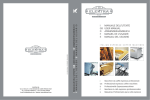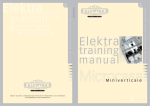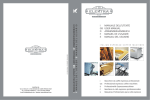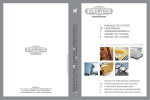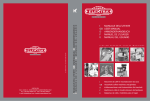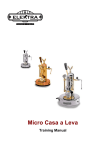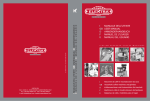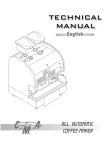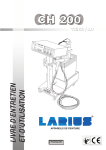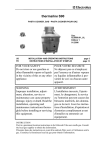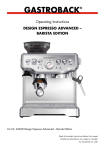Download Elektra espresso coffee machine - 1st
Transcript
M A C H I N E S E S P R E S S O C O F F E E A.D. HOLBEIN & PARTNERS / TV M A C H I N E S Elektra training program I T A L I A N I T A L I A N Equipment C O F F E E program E S P R E S S O Elektra SHARING THE PASSION Equipment Elektra srl - Via A. Volta, 18 - 31030 Dosson di Casier ( Treviso ) Italy - Tel. +39.0422.490.405 r.a. - Fax +39.0422.490.620 E-mail: [email protected] - Web: www.elektrasrl.com b o o k 1 o n e INTRODUCTION “ “ What is the main Elektra's desire in the espresso coffee world? ” Transform every good barista in a First Class Barista! ” Coffee is linked to the important moments of our daily routine: its aroma wakes us up in the morning and picks us up during work breaks, its particular flavor lends the final touch to any meal and animates moments at the café with friends. Part of its success is also to be attributed to all the people involved in the production of espresso coffee machines, such Elektra All contents of this publication, including photos and illustrations (except those courtesy of Mocha Coffee) are the exclusive property of Elektra Srl and cannot be duplicated, sold or used outside their intended purpose without the written permission of the publisher. that since 1947 bases its work techniques on the finest craftsmanship values, and where machines are still made, one by one, according to the as Elektra. Participant notes Elektra Training Program. Elektra, the Italian company training program unsurpassed methods of craftsman expertise. Elektra's mission is to supply a total quality product with an elegant and refined design as to effectively make it a "multi-purpose interior design element". SHARING THE PASSION Equipment 01 CONTENTS 1.INTRODUCTION 1.Introduction Program outcomes 3 2.Espresso equipment Principles of an espresso machine 4 Elektra espresso coffee machine 6 Pressure gauges 8 Pushbuttons (Automatic machine) 8 Automatic and Semi-automatic 9 Welcome to the Elektra training program. 3.Using espresso equipment 4.Further information 11 Start up from cold 14 Normal opening procedure 16 Shut down procedures 17 Chemical cleaning procedures 18 Routine maintenance 18 Extracting coffee 19 Using the grinder 23 Troubleshooting 24 Glossary 28 Program outcomes When you have finished this program, you’ll be able to: 1. Explain the basic operation of an espresso coffee machine. 2. Identify the major parts of an Elektra espresso coffee machine. 3. Installation. 4. Prepare an Elektra espresso coffee machine for use. 5. Chemically clean an Elektra espresso coffee machine. 6. Shut down an Elektra espresso coffee machine. 7. Monitor the operation of a commercial dosing coffee grinder and make adjustments as required to ensure ground coffee is fresh and of the correct texture. 8. Fill a single or two cup handle with ground coffee to correct height, and tamp coffee to correct density 02 We know you will enjoy this very practical course, and as you’ll see, making good coffee is truly an art… Our program usually takes six to eight hours, over two attendance sessions. At the end of each attendance, we will issue you with a certificate, but we first need to make sure you have learnt the essential survival skills. To do this we will ask you to set-up the machine and the grinder. Commercial espresso dosing grinder 10 Adjusting the grinder Welcome to the Elektra training program. Our aim is to give you the coffee making skills practiced by baristas around the world. You’ll use a range of sophisticated espresso machines and follow time honoured practices as you learn the art of making a perfect cup of coffee. 03 9. Fit filled handle to espresso coffee machine and operate the machine to produce a range of coffee drinks. 1 0 Identify faults with an Elektra . espresso coffee machine and take appropriate remedial action. (This includes identifying faults that require the service agent to remedy, and fixing those faults within the scope of the user). 2.ESPRESSO EQUIPMENT Principles of an espresso machine Most commercial espresso machines work on the same principle, although they can have considerable differences in how they achieve this. The diagram below shows the hidraulic diagram of an Elektra machine. 2.ESPRESSO EQUIPMENT Parts in an Elektra espresso machine Hydraulic diagram 1. 2. 3. 4. 5. 6. 7. 8. 9. 10. 11. 12. 13. 14. 15. 16. 17. 18. 19. 20. 21. 22. 23. 24. 25. Basic construction of an Elektra espresso coffee machine. 13 water supply water softener entry water connect motor/pump one way valve inlet sol. valve boiler heat exchanger safety valve va valve filter gigleur orefice steam valve hot water valve expansion valve gauge group solenoid valve coffee delivery group filter water flow meter filter holder hot water cold water electric heating element sensors 11 10 22 8 12 6 18 7 17 21 16 • Heat exchanger Also a special sanitary copper cylinder, the heat exchanger is inside the boiler, and is partially covered by the boiler water. As cold water drawn from the mains is passed through the heat exchanger, it heats to the required temperature before passing through the coffee grounds. The pressure to do this is provided by the pump. 19 14 20 24 5 15 2 1 23 3 Operating principles Boiler This is a special sanitary copper cylinder with an electric heating element that heats the water to a preset temperature. Because the water is under pressure, the temperature of the boiler water is slightly higher than 100°C (boiling point of water at sea level). The boiler provides steam, boiling water and also heats the water passing through the heat exchanger. • 25 9 • Water is heated in the boiler(7) to a preset temperature with an electric heating element(24). Most machines maintain the boiler water level automatically with sensors(25) in the boiler that cause a valve to open and thereby maintain the level as water is drawn off. The water that passes through the coffee grounds is heated in a heat exchanger(8). This is simply a tube surrounded by the boiler water, and the machine settings ensure the water passing through the exchanger, and then through the grounds is at 98°C. The pump provides pressure for both filling the boiler, and to force heated water through the coffee grounds. 04 4 Steam and boiling water are provided by the boiler, available through outlets controlled by manually operated valves. These are either lever operated valves, or taps turned with a knob. Most commercial espresso machines have electronic control circuits to ensure correct water temperature and boiler level. Some also automatically control the amount of water dispensed into a cup for each type of coffee drink. • Pump Driven by an electric controlled motor, the pump pressurises the water for entry into the boiler, and also for passage through the heat exchanger and the ground coffee, which is held in a coffee handle. The Elektra pump is made in a special naval brass. • Handles Coffee handles come in two basic forms: single and double cup. A filter basket containing the ground coffee fits into the handle, which then clips into a group head so water from the heat exchanger can pass through the grounds and into one or two cups, depending on the type of handle. The Elektra handles are ergonomic and provided whit special bakelite handle. 05 Filter basket This is a small perforated stainless steel container to hold ground coffee. A one cup basket has less capacity and a slightly different shape to a two cup basket. (See photos next page). • Group heads A group head delivers hot water under pressure to the ground coffee held in a coffee handle locked into the group head. Machines are classed by the number of group heads, with most commercial machines having at least two. The Elektra group heads has been patented and is opened in two parts. • Steam and hot water Steam is used to froth milk and is available through the steam wand. Steam passes through the wand when a valve is opened manually, either by turning a tap or operating a lever. Hot water is available “on tap” through a hot water outlet, again by manually opening a valve. The Elektra’s valves are completely made by Elektra. These parts are in virtually all espresso coffee machines. Commercial machines also have other facilities, like pushbutton operation and flow sensors to automatically measure the quantity of water being dispensed for each type of coffee drink. 2.ESPRESSO EQUIPMENT Elektra espresso coffee machine There are various models in the Elektra range, including the Barlume, shown below. 2.ESPRESSO EQUIPMENT The Elektra Balume features pushbutton operation, and flow meters to guarantee just the right amount of water into a cup, regardless of the grind density. Hot water tap • The hot water tap on the Barlume The hot water tap feels “loose” when closed Steam wand • The Barlume has two steam Steam wand. Always move wand with rubber clip. is operated with a rotary knob, like a normal water tap. However, the “feel” is different. In a normal water tap you feel the washer tighten as you close the tap. On the Barlume, the hot water tap has a spring loaded washer, which means that as you turn the knob clockwise (for off), a point is reached when the knob feels loose. This is the off position. Turning the knob anticlockwise progressively opens the tap, allowing more hot water to flow. wands. Like the hot water tap, these are operated with a rotary knob. Again the knob will feel loose when the tap is closed. The steam wands can be moved horizontally to suit. Always move the wands with the rubber clip, as the metal wands will be very hot. Remember that the steam passing through the wand is hotter than 100°C because the boiler is under pressure. Boiler. Made from sanitary copper, the boiler pressure is typically 1 bar (14psi), protected with a pressure release valve set to 1.5 bar. Pump. Driven by an electric motor (behind), it delivers a pressure of 8 bar to the handles. The boiler and pump in an Elektra espresso coffee machine. Group head, handles and filter baskets However, you will also find that the temperature of the steam a few centimetres from the wand will have very little heat, so the danger is from steam heating the metal tap, and from steam near the wand’s outlet. Lever operated valves • Some other Elektra espresso Group head (above) single cup handle. (below) single cup filter basket. Single cup handle filled with grounds; locks into group head shown above. 06 (above) two cup handle. (below) two cup filter basket machines have levers to operate the hot water and steam outlets. Moving the lever away from its normal horizontal position opens the valve. hot water lever Elektra espresso machine with levers to operate the steam and hot water. Moving a lever in any direction opens the valve. 07 rubber clip 2.ESPRESSO EQUIPMENT Pressure gauges All the Elektra coffee machines are provided with a dual pressure gauge to show pump pressure (left side) and boiler pressure (right). The pump pressure is the water pressure at the pump outlet, 2.ESPRESSO EQUIPMENT so when the pump is off, the pressure reading is the inlet water pressure. This is set by a regulator fitted to the water inlet line, and should be no more than 3.5 bar. AT START UP boiler pressure pump pressure DANGER No water (pump) pressure. Don’t turn the machine on. Water (pump) pressure should be around 3.5 bar when pump is not running. Ok to turn on. (Automatic machine) Pump off (3.5 bar), boiler pressure in green region (1 bar) Pump on (8 bar), boiler pressure in green region (1 bar) When the machine is making coffee, the pump turns on to force water through the grounds. The pump pressure increases to 8 bar (green region on left side scale). The boiler pressure will drop slightly, but should remain at around 1 bar. If the pressure readings go into the red, switch off the machine. Although the boiler is fitted with safety release valves, if the gauges show a high pressure, something is wrong. The Elektra Balume is an automatic machine in which pressing a pushbutton dispenses a fixed quantity of water (measured by an internal flow meter), except for the K button, which is an on-off control. single cup The Elektra coffee machines are available in semi-automatic and automatic. In an Automatic machine the water flow is measured by flow meters in the machine. This means the barista simply presses a button to make a particular coffee drink, with the machine turning off the flow automatically when exactly the right amount of water has been dispensed into the cup (or cups for a two cup handle). The amount of water dispensed is not affected by the density of the coffee grounds, so you are always assured of the right level. The finer the coffee grounds, the longer it This version of the Elektra Classic is an Automatic machine with pushbuttons to control automatically the water flowing through the group heads. RUNNING Pushbuttons Automatic and Semi-automatic This Elektra machine is also Semi-automatic, but with pushbuttons (shown enlarged) to control water flow through the group heads. Press button to start water flow, press again to stop. Double cup Buttons as for single cup levers to control water flow through group heads GREEN INDICATORS: Flashing indicates higher than usual back pressure. Normally ok to continue. power switch espresso macchiato cappuccino 08 flat white mocha latte 12oz takeaway lungo vienna 8oz takeaway manual flow, press for on, press again for off. 09 will take for the water to be dispensed. The amount of water for each type of coffee drink is factory set, and can only be changed by a technician. A Semi-automatic machine has either pushbuttons or levers to control the group head water flow for making coffee. The levers on a semiautomatic machine operate internal switches, so flicking a lever has the same action as pressing a button. The water flow is not measured by the machine, so the barista has to turn off the flow when the cup (or cups) contains the right level of extracted coffee. 2.ESPRESSO EQUIPMENT Commercial espresso dosing grinder In the Elektra range, the grinder is a separate unit to the espresso machine. A typical Elektra commercial dosing grinder is shown below. 2.ESPRESSO EQUIPMENT Grinder blades • The blades are made of two discs Commercial dosing grinder which are precisely machined to produce a uniform grind. One disc is attached to an adjusting wheel and remains stationary. The other disc is turned by the motor. hopper dispenser and dosing unit grind adjustment wheel press or tamper motor housing and machine body bottom grinding disk attached to motor Adjusting the grinder The hopper • This holds the coffee beans and should be kept filled to the top. Otherwise you run the risk of emptying it, which will cause the dispenser to empty. When this happens, level control switches in the dispenser operate, turning on the grinder motor. Because there are no beans, the motor will run continually, and at maximum revs, eventually burning out. So, whenever you see the plastic grille, fill the hopper immediately, and train all users to do the same. Grinding discs in a commercial grinder. One disc is rotated by the motor, the other is fixed and is attached to an adjusting wheel. Also, never put ground coffee into the hopper, as this will overload the motor and cause it to quickly burn out. There are two main adjustments for the grinder: the grind consistency and the dose. The dose is factory set and should not need adjustment. The grind consistency however could need to be adjusted several times a day, so it’s important to understand the adjustment and when to make it. The grind adjustment is achieved by rotating an adjusting wheel, which moves the grinding discs closer or further apart. Do this one notch at a time. ADJUSTING WHEEL: Side view Top view grinding blade fixed to wheel plastic grille fine thread finer grind Dosing unit • The dosing unit sits on the bottom dosing chamber of the dispenser. It rotates by one chamber with each pull of the dosing lever, causing a fixed quantity of grounds to be dispensed into the coffee handle held under the dispensing hole. The dosing quantity is adjustable, but once set, does not normally need to be changed. (Note that the bottom cover and a switch have been removed for clarity of photo). dispensing hole 10 Underside view To adjust the consistency of the grind, release locking lever and turn the wheel anticlockwise one “click” at a time to make the grind finer. You can tell when the grind is incorrect by the flow of brewed coffee into the cup. However, don’t change the grind until you have made three or so cups of coffee, in case other factors are causing the problem: did you fit the handle correctly, did you tamp the grinds to the right density, is the dose correct? 11 locating notches If the flow is too slow, the grind is too fine. In general, it should take 25 to 35 secs to extract a good cup of espresso. UTILIZZARE MACCHINE PER CAFFÈ ESPRESSO Elektra training program SHARING THE PASSION delle macchine per Caffè Espresso 12 13 3.USING ESPRESSO EQUIPMENT Start up from cold We recommend leaving espresso machines on overnight. However you might need to turn the machine off, requiring a cold start the next day. At start-up, the machine will have been cleaned at shut down in preparation for the next use, as shown below. At start-up, the coffee handles and milk jugs are cleaned ready for use, cups and glasses are stacked for warming, and the pump pressure gauge is reading the inlet water pressure. steam wand, cleaned and left outside jug milk jug, cleaned after last use coffee handles, cleaned after last use 3.USING ESPRESSO EQUIPMENT 5. Flush group heads. At this stage, although the machine is up to pressure, it’s important to remove all stale water from the heat exchanger and group heads. To do this, flush the group heads for 20 seconds. On an automatic machine, press the button under each group head. After 20 seconds, press it again to turn off the flow. On a lever/semi-auto machine, operate the lever or pushbutton for 20 seconds or so. Although the boiler pressure is correct, using the machine will cause the pressure to drop, with some time required for the pressure to return to the normal 1 bar level. This is due to air in the boiler being compressed by the expanding water. As water is drawn off, the boiler pressure will stabilise as it reaches normal operating conditions. F l u s h i n g a g ro u p h e a d 6. Work the machine. It normally The procedure to start up an espresso machine from cold is: 1. Check the pump pressure gauge before switching on the machine. If it shows 0 don’t turn the machine on, as there is no water pressure to the machine. Check water supply. 2. If the pump pressure shows around 3.5 bar, turn the switch to position 2. Position 1 is the illuminating position, in which the machine’s lights are on for show. S w i t ch i n o f f p o s i t i o n 3. Wait until the boiler pressure gauge shows about 0.5 bar, then release steam for 4–5 secs. Do the same with the hot water. This ensures there’s no air trapped in the lines. Lights on position 4. Wait until the boiler pressure gauge shows around 1 bar (green area). Although the machine is now ready to use, it is still not hot enough for best coffee. takes around half an hour for an espresso machine to reach proper operating temperature from cold. During this time you should “work” the machine by operating the steam wands and hot water spout, and also by passing hot water through the group heads. When the machine is operating correctly, the boiler pressure will return quickly to its normal 1 bar value. During warm up, it can take some time for this to happen. As well, when the machine is properly warmed, the water temperature passing through the group heads will be around 98°C. Before warm up it will be as low as 85°C, which makes poor coffee. The sound of the machine tells you if it’s up to temperature: when it’s too low, you hear a soft steaming sound. When it’s up to temperature the steaming sound is stronger and more consistent. Hot water tap open before boiler fully up to temperature and pressure, giving some steam and hot water. Hot water tap open with boiler up to temperature and pressure, giving lots of steam and hot water the group heads with coffee. The first cup will not taste right, as it will have absorbed whatever was lining the group heads (soap, water etc). 7. Extract a short black. When the 8. Empty filter basket, wash basket Normal operating position 14 machine is up to temperature and pressure, run a short black through both group heads by pressing the button. Ok, it wastes a cup of coffee, but it lines 15 and handle under hot water, replace handle in group head. You are now ready for business. 3.USING ESPRESSO EQUIPMENT Normal opening procedure Normally you would leave the espresso machine on overnight. On the Elektra Barlume, this is switch setting 2. On other machines, this is typically the ON position (switch position 1). Leaving the machine on overnight means you can be ready to serve coffee in a few minutes, compared to waiting half an hour with a cold start. The normal opening procedure is: 3.USING ESPRESSO EQUIPMENT condensation drained from steam wand At the end of the day, shut down the machine as follows: Remove condensation from steam wand by inserting wand into a milk jug and briefly releasing steam seal area shower head 3. Fit a blind filter to any handle, making sure blind filter is properly inserted. 4. Firmly place handle fitted with blind filter to any group head. Press the K button (or delivery button/lever on semi-auto machine) for six seconds. This back flushes the group head. Note that on an auto machine the green light over the K button will flash after six or so seconds to indicate restricted flow. This is normal. It is essential to watch the machine during this operation, as considerable pressure is built up. jugs and turn on the steam for a second or so then turn it off. This should remove all condensation in the wands. 3. Press the single filter basket into the single handle and the double filter basket into the double handle. 4. Load both handles with coffee and Flushing shower in group head to remove oils 5. Grind fresh coffee in all dosing grinders. After the fourth time, wait 3–4 seconds for pressure to be released before removing handle. Otherwise you could be scalded or burnt, and the group seal could drop out of the group head, requiring repairs to be made by the service agent. as described in steps 4 and 5 above. Then rinse each group head by running hot water through the head (K button) for 10 seconds or so. dles and press K buttons for both groups for a second or so to flush out oils from the showerheads. Then place the handles back on the group heads. Blind filter. Used when back flushing group head and handle. 5. Repeat back flushing four times. 8. Remove drip tray. Hold a cloth 6. Back flush remaining group heads 6. Empty used coffee from both han- under the drip tray outlet and carry tray to rinsing area. Rinse in soapy water (careful of sharp edges), rinse totally, shake off excess water, wipe bottom of tray with a cloth and replace immediately in position. Never leave the tray off the machine, as the ele tric wiring is exposed, creating a danger to those working the machine. As well, damage can be done to the machine if water reaches the wiring. 7. Release steam for a few seconds 9. Gather all utensils and handles. Priming group heads and handles filled with ground coffee 16 Under side of group head. Clean seal area with brush. Fill two clean stainless steel milk jugs with cold water and submerge steam wands into water. Open both steam taps for a few seconds to flush steam wands. At this stage, leave wands submerged in water so they can soak to allow easy removal of milk deposits. head brush by vigorously moving brush around group seal area. Press K button for a second or so to flush each group head. 2. Insert the steam wands into milk place handles into group heads. Prime the group head assemblies by switching on both groups and letting coffee run into the drip tray for about 15 seconds. Leave handles filled with coffee grounds in group heads. 1. Remove handles from machine. 2. Clean group heads with group 1. Press each continuous delivery button (the button). You will eventually hear a soft steaming sound build up in both group heads. Once the steaming sound has stopped, switch off both groups. At this stage, don’t fit the handles. Shut down procedures through steam wands, which are still submerged in water. Remove wands from jugs and wipe wands with a clean damp cloth. 17 Remove filters from handles and wash everything in a sink using a plastic scourer and washing up detergent. Rinse everything and store on espresso machine. 3.USING ESPRESSO EQUIPMENT 3.USING ESPRESSO EQUIPMENT Extracting coffee 10. Wipe the machine with a damp paper napkin, then wipe over with a dry cloth to remove all streaks. 11. Store cups and glasses on warming tray so they can heat overnight. Chemical cleaning procedures This is typically done three times a week, eg Monday, Wednesday and Friday. First carry out the normal shut down procedure, except back flush each group once only, making sure to wait 3–4 seconds before removing handle. Then: Preparation 1. Place espresso cup under hot Fill coffee handle 2. Fill a warmed coffee handle with 1. Add half a teaspoon of espresso 4. Heat all filter baskets and handles detergent to blind filter and place blind filter into handle on left hand group head. Back flush six times. Wait 3–4 seconds for pressure to release, then remove handle and flush water through group head for a few seconds. 2. Repeat this procedure for each group head. 3. It’s a good idea to also back flush each group head with water after the above procedures (see step 4 on previous page). As well, before leaving the machine, check that all taps are off to avoid water dripping all night. by immersing them in a container half filled with hot water from machine. Drain this water and add 3–4 teaspoons of detergent, followed by enough hot water to cover all metal parts. Fill with hot water from machine and wash all parts thoroughly. Take care not to breathe in the fumes, and avoid getting the detergent on your skin or any part of your body. The detergent will become frothy as it does its work. When the cleaning reaction is over, drain the soapy water and gently scour each part with a plastic scourer and a mild detergent. Then rinse each part. For a single cup, dispense grounds with two “flicks” of the dosing lever, followed by tamping (press but don’t bounce the tamper). Then twist the tamper to feather coffee grounds to side of filter basket, ensuring there’s no gap between the coffee grounds and the side of the cup. Don’t twist while tamping. After a chemical clean, before starting the next day run three cups of coffee through each head to remove any traces of detergent. Also make sure all handles are used in this process. At regular intervals (eg at least three times a day) clean group seals with group head brush by briskly moving the brush around the seal area to remove coffee grounds. Then briefly flush group heads with hot water (operate K button on an auto machine). Rinse coffee handles (fitted with filter baskets) under hot water from hot water tap, then fit handles firmly onto group heads and flush oils and remaining coffee grounds by operating the K button for a few seconds. water tap, and fill with hot water. While cup is heating, prepare saucer, spoon, soy chocolate bean and glass of iced water. Unless the ambient conditions are hot, empty cup and fill it again with hot water. For takeaway, ask customer if sugar is required and place requested amount in cup. ground coffee from grinder. (Note that handles should always be left on group heads, cleaned, warmed and ready to use.) Get the level right Routine maintenance The procedure for extracting a short black (espresso) coffee is described here in some detail, even though some of the following information has already been presented. The level of coffee grounds in the basket is important. Too low gives tasteless coffee and the coffee cake will fall apart when removed, leaving lots of grains in the coffee filter. This means more cleaning and wasted time. If the level of grounds in the handle is too high the handle won’t fit into the group head. If this happens, remove the ground coffee in the filter and reload with fresh coffee. The shower insert inside the group head should just contact the top of the coffee grounds, so too much coffee will prevent the handle fitting to the group head. For a double cup handle, flick dosing lever twice, tamp, twist, then one more flick of dosing lever, followed by tamping and twisting. Regularly check the dosing chamber to confirm coffee grounds are filling all dosing compartments. If not, start the grinder, then when enough grounds are present, release eight doses of coffee into a container (eg, lid of dosing chamber) and return the coffee to the dosing chamber. This ensures all compartments have been worked and the coffee is settled. grounds left in filter basket after emptying coffee cake breaks when emptied from basket If the level of grounds is too low, the coffee “cake” will fall apart when removed, leaving lots of grounds in the filter basket 18 19 3.USING ESPRESSO EQUIPMENT The photos below show how coffee cakes should look when emptied from the handle. The art of tamping 3.USING ESPRESSO EQUIPMENT Correctly filled handle should release cakes that don’t break apart Single cup coffee cake Two cup coffee cake Tamping compresses the coffee grounds to give the correct flow of water through the grounds. Tamping is essential to obtain uniform and complete extraction of coffee from the grounds. The flow of water is determined by the grind texture, the dose and the amount of tamping. Generally the dose is correctly set, so the water flow is mainly determined by the amount of tamping, and most importantly, the fineness of the grind. The following photos show flow rates for coffee that has been ground too coarsely, correctly and too finely. The correct flow will ensure the best tasting coffee. Flow too high grounds too coarse Flow correct grounds correct Adjusting the grind. If the flow is too fast, the grounds are too coarse or tamping is too light. If the flow is too slow, the grounds are too fine or tamping too heavy. As already explained, you might need to adjust the grind texture. For details see page 12. But importantly, adjust the grind adjusting wheel one notch at a time. Clean rim of filter basket Before fitting the handle to the group head, be sure to remove any coffee grounds on the rim of the filter basket. Otherwise you won’t get a good seal, and a build up of grounds around the seal area can damage the seal. Flow too slow grounds too fine Fit handle to group head 3. It is important to fit the handle correctly to a group head. When fitted, the handle butts against a sealing ring inside the head, and the shower insert is just against the coffee grounds. During operation, the whole assembly is under considerable pressure (8 bar or over 110psi). If the seal between the handle and the group head is too loose, water can flow through the seal and outside the head. Furthermore, the handle could release itself from the head during the coffee making process, with coffee grounds, boiling water and cup going in all directions. Clearly a dangerous situation! In this photo, the handle was not correctly fitted to the group head. This caused the handle to release when the pressure increased, causing a hazard to all. The rubber seal in the head can also become dislodged by coffee grounds being forced behind the seal. This will make it difficult to work the handle, and means the head needs to be disassembled and cleaned by the service agent. Incorrect: handle not tight enough in head 20 The filter basket rim fits against a rubber seal in the group head. It’s important to make sure the top of the basket is free of coffee grounds to get a good seal, and to prevent damaging the seal. 21 Correct: handle firmly locked into position 3.USING ESPRESSO EQUIPMENT Extract coffee Clean up 4. If the machine has not made a coffee for 15 minutes or so, work the group head by letting hot water flush through the head. This will warm the head and build up pressure in the machine. Then fit the handle firmly to the group head and press button to make a short black, or operate lever or manual pushbutton (on a semi auto machine) until cup is half full. 3.USING ESPRESSO EQUIPMENT On an auto machine, press the button for making a short black. It should take around 25–30 seconds to make and will half fill the cup. Using the grinder • Automatic control, in which two switches inside the dosing chamber sense the level of ground coffee, and operate the grinder motor as the grounds falls below a preset level. This ensures a supply of ground coffee while the grinder is switched on. (Not all commercial grinders have this feature). A commercial dosing grinder has several features: level switches on top inside • Exact dosing of ground coffee. This is achieved inside the dosing chamber, in which a precise amount of ground coffee is dispensed when the dosing lever is operated. Always operate the dosing lever over its full stroke to ensure a full dose of coffee grounds. 5. Remove handle and dislodge coffee cake into dumping box by hitting side of handle against rubber covered bar in box. Hitting the handle against a metal surface will cause dints in the rim of the filter basket and reduce its ability to seal. Rinse handle under hot water to remove remaining grounds and flush group head to remove coffee oils. Put handle loosely in group head ready for the next cup of coffee. To empty coffee cake, hit side of handle on rubber coated bar to dislodge cake into dra er. Take care not to damage rim of filter basket. To fill a coffee handle: 1. Hold handle fitted with filter basket 2. 3. 4. When finished making coffee, rinse handle and flush g ro u p h e a d 5. Then put handle loosely in group head to keep it warm and ready for next use on support bracket. Operate dosing lever twice. Tamp grounds then twist tamper to feather grounds to side of basket. For a two cup handle, operate dosing level once more, then tamp and twist. Wipe rim of filter cup to ensure it’s free of grounds. tamper to pres grounds in filter basket dosing lever support bracket when filling coffee handle 4 mm The photos below show examples of filled filter cups: power on-off switch rim cleaned and free of coffee grounds grounds feathered to side of basket by twisting tamper Single cup handle with insufficient grounds. 22 23 Single cup handle filled, tamped and feathered correctly. Troubleshooting 1. Coffee quality 4.FURTHER INFORMATION 4.FURTHER INFORMATION Use this section to help solve problems with your espresso machine or with the quality of coffee it’s making. PROBLEM SOLUTION Coffee grounds in cup • Group head seals not cleaned 2. Grinder PROBLEM SOLUTION Taste • Group heads and handles not cor- poor coffee taste (assuming blend is correct) • Coffee grounds on bottom of handle spout. This can be caused by excess grounds on grinder tray. rectly cleaned and primed after start-up or after a chemical clean. • Filter basket fell into dumping box when handle was being emptied. (Rinse filter basket and handle.) • Machine not worked enough to bring it up to proper operating temperature. • Handle too loose in group head. • Group head too cool, often due to excessive and unnecessary flushing of group heads, resulting in a lot of cold water being introduced to heat exchanger. • Grind texture too coarse or too fine. • Insufficient grounds in handle. • Excess grounds in filter basket Insufficient dose of coffee grounds being supplied to handle • Pressed wrong button (eg, pressed long black for a cappuccino). • Incorrect use of dosing lever (make sure to operate the lever over its full stroke). • Human error in which you filled a double cup filter with two doses of grounds rather than three. Often happens when you are busy — slow down. • Dosing chambers in grinder not • Coffee cup not heated before use. completely filled. Check that grinder is switched on and operate dosing lever to cause level switches to operate grinder motor. Then operate dosing lever up to 16 times, observing that each dosing chamber is being filled by grounds as you operate the dosing lever. Catch dispensed coffee in a cont a i n e r, a n d r e t u r n c o f f e e to dispenser. • Milk too hot (boiled) or too cold. • Milk frothed too much or not enough for the drink. (Eg, milk is frothed less for a latte or flat white than for a cappuccino.) • Handle not fitted firmly on group head. • Grounds incorrectly tamped in filter basket. • Stale coffee. Poor crema properly, causing incorrect seal and allowing grounds to flow outside handle and into cup. • This can also be due to the grounds being light and airy, often caused when the grinder is turned on after having been turned off overnight or during the day, or if coffee has not been dispensed for some time. Switch on the grinder, remove lid of dosing container, place under dosing hole and dispense eight doses of grounds, and return to container. Repeat if necessary. That is “work” the grinder. • Coffee grounds too coarse or extremely fine. • Level of grounds in filter basket too low: was a full cake produced when basket emptied? • Handle not firmly locked in position. • Group heads running too hot (generally only on very busy days). • Poorly tamped grounds, or not tamped at all. Extracted coffee levels incorrect • Wrong button pressed for type of drink. See page 24 for details of Elektra pushbuttons. Grinder switched on but not running • Preset levels need adjusting by service agent (not a typical cause). 24 25 • The level switches inside the dosing container may be held off by the way the grounds are sitting in the container, whether it’s nearly full or empty. To remedy, “work” the grinder. 4.FURTHER INFORMATION 3. Group head 4.FURTHER INFORMATION PROBLEM SOLUTION Handle not fitting correctly on group head • Group head seals not cleaned correctly (excess grounds covering seal area, see page 17). 4. Steam wand PROBLEM SOLUTION Poor quality milk froth • Milk not cold enough before starting Steam wand not producing enough steam • Steam wand nozzle partially or fully Steam flowing through wand while tap turned off • Confirm tap is turned fully off. If so the Water overflowing from drip tray • Water catchment box blocked with • Filter basket not correctly clicked into handle. • Excess grounds in filter basket (see page 21). • Group seal has dropped, often caused by operator not removing or fitting handles correctly. (Call service technician.) Incorrect water flow through group head (fitted with filled handle) See pages 19–20 for further information on the following, which can all affect flow rate: • grind texture • tamping frothing, causing the milk to be fully heated before being fully frothed. • Using previously heated milk without adding cold milk. See page 27. • Seasonal problems with milk. This is rare, but on occasions milk can be supplied that will not froth properly. Obtain milk supply from another source for duration of seasonal problems. blocked. Either use other steam wand or clean defective nozzle by submerging it in a jug of cold water for around five minutes. and then operating wand. If this does not unblock it, you may need to call the service agent. washer might need replacing, which is done by the service agent. • quantity of grounds in filter basket • handle not firmly on group head • pump pressure (normally 8 bar). coffee grounds • Drain tube blocked with coffee grounds. • Drain tube sagging, and creating a Poor water flow through group heads (no handle) • If pump pressure is correct (8 bar), Group head steam pressure below normal (machine sounds weak) • Operate group heads, steam wands Group head running too hot (eg steam pressure above normal) • On a busy day the temperature of the 26 blockage. • If draining into a bucket, a sag in the line the shower head could be partially blocked with coffee oils. This is caused by negligence and improper cleaning, and builds up over a period. Chemically clean machine three times (see page 18) and call service agent to check condition of heads. can cause an air pocket. and hot water outlet to bring machine up to pressure (see page 15). water passing through the group heads from the heat exchanger can rise above normal, resulting in poor coffee and a very strong steam sound. When this happens, prior to making the next coffee, remove coffee handle and run water through the group head This will introduce cold water into the heat exchanger and “soften” the steam flow. That is, the machine should sound as though it’s operating normally. 27 4.FURTHER INFORMATION Glossary The following terms mainly relate to an espresso machine and its operation. See Coffee tasting terminology for terms related to coffee. TERM WHAT IT MEANS Automatic a machine that dispenses a measured amount of water into a cup, turning off the flow automatically. back flushing the action of blocking the flow of water through a group head with a blind filter, and operating themachine as if extracting coffee. bar unit of pressure equal to 100kPa or 14.5 psi or one atmosphere. barista Italian, person working in a bar, commonly used term for someone working a coffee bar. blind filter a filter basket without holes, fitted to handle and used to back flush group heads. dose the amount of coffee dispensed by a dosing coffee grinder each time its dosing lever is operated. espresso the name given to a type of coffee making machine that uses pressure to force heated water through ground coffee beans (sometimes spelt expresso). feathering twisting a tamper to spread coffee grounds smoothly to the edges of the filter basket. heat exchanger a device such as a tube immersed in heated water, in which a liquid is heated by another liquid without physical contact between them. manual a machine in which all actions, including pumping are done by the operator. mocha a variety of coffee (from Mocha). Also a flavouring obtained by combining coffee and chocolate. semi automatic a machine that requires the operator to start and stop water flow during coffee extraction. solenoid valve an electrically operated water valve (in an espresso machine). tamping pressing coffee grounds in filter basket to a consistent density to ensure best coffee extraction. valve a mechanical or electrically operated device that controls the flow of water or steam in an espresso machine. 28
















